Introduction
This 25-minute hands-on tutorial shows you how to manually export dimension metadata from Enterprise Data Management Cloud to a connected Planning environment, and then import the metadata into Planning. The sections build on each other and should be completed sequentially.
Background
Enterprise Data Management Cloud provides multiple solutions for managing changes in your business by ensuring consistency across enterprise data, even across disparate applications.
You can export dimension metadata from Enterprise Data Management Cloud to a Planning instance manually or by using the EPM Automate utility. You can also create a Groovy business rule in Planning that calls the Enterprise Data Management REST API to export the dimension metadata, then imports the metadata to Planning using a saved import job.
In this tutorial, you update the Product dimension in Enterprise Data Management Cloud and then synchronize the changes to Planning by manually exporting the dimension and then importing it to Planning.
Note:
See the Next Steps section for links to tutorials on using EPM Automate and Groovy rules.Prerequisites
An EPM Cloud Service instance allows you to deploy and use one of the supported business processes. To deploy another business process, you must request another EPM Enterprise Cloud Service instance or remove the current business process.
- Have Service Administrator access to two instances of EPM Enterprise Cloud Service. The instances should not have business processes created.
Tip:
If you have already set up these instances for one of the tutorials listed in the Next Steps section, you can continue to use the same environments and skip these prerequisites tasks. Your results may vary from those shown in the screenshots for this tutorial, depending on whether and in which order you have completed the related tutorials. - Configure one of your instances for Enterprise Data Management Cloud and configure the other instance for Planning.
- In your Enterprise Data Management Cloud instance, create a sample application. For more information, see the documentation.
- Upload and import this snapshot into your Planning instance. For more information on uploading and importing migration snapshots, refer to the Administering Migration for Oracle Enterprise Performance Management Cloud documentation.
Managing and exporting Planning metadata in Enterprise Data Managment Cloud
Setting up a connection to the Planning application
In this section, in Enterprise Data Management Cloud, you set up and test a connection to your Planning application so that you can export dimension metadata directly to the Planning instance inbox.
- On the Enterprise Data Management Cloud home page, click Applications.
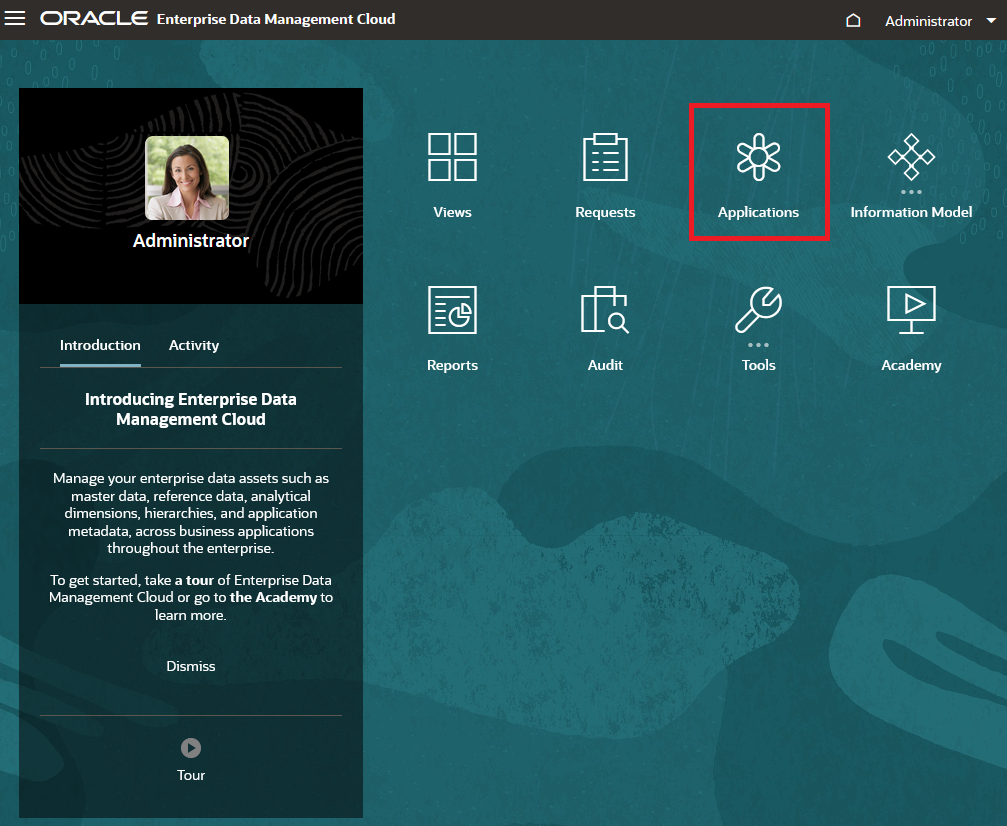
- In the Applications page, click Corporate Planning to open the inspector.

- In the Corporate Planning application inspector, select the Connections tab.
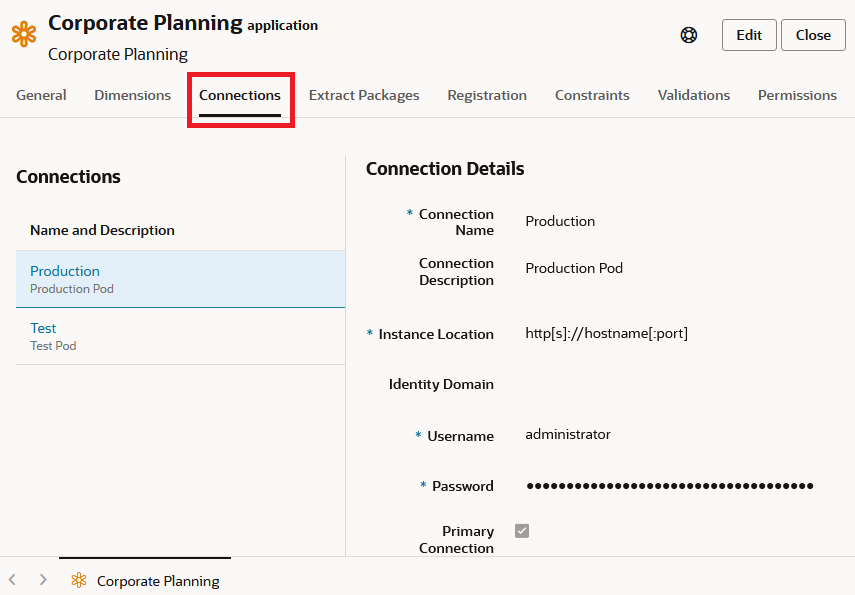
- Select the Production connection, then click Edit.
- Modify the connection details for your Planning instance:
Field Valid Values Example Instance Location Enter a connection URL to your Planning instance in the format: https://ServiceName-IdentityDomain-ServiceType.DataCenter.oraclecloud.comhttps://planbudget-uscompany-entplan.US11.oraclecloud.com
where
ServiceNameisplanbudgetIdentityDomainisuscompanyServiceTypeisentplanDataCenterisUS11
Identity Domain Enter the identity domain of your Planning instance. Note: This is the same Identity Domain used in the Instance Location.
uscompanyUsername Enter an authorized user name. Note: The user must be a Service Administrator of the Planning instance.
tom.smithNote: You must enter the identity domain in either the Identity Domain or Username fields. For example, enter
uscompanyin Identity Domain oruscompany.tom.smithin Username.Password Enter the user's password. xxxxxxxx - Select Primary Connection to make this connection the default for importing and exporting.
- Click Test Connection.

The message "Connection Successful" is displayed.

If your connection test is not successful, check the connection details and try again.
- Click OK, then click Save.
- Click Close to close the inspector, then return to the home page.
Adding a product
Currently, the Product dimensions in Enterprise Data Management Cloud and Planning are in sync. In this section, you add a new product to the Corporate Planning application in Enterprise Data Management Cloud.
- On the Enterprise Data Management Cloud home page, click Views.
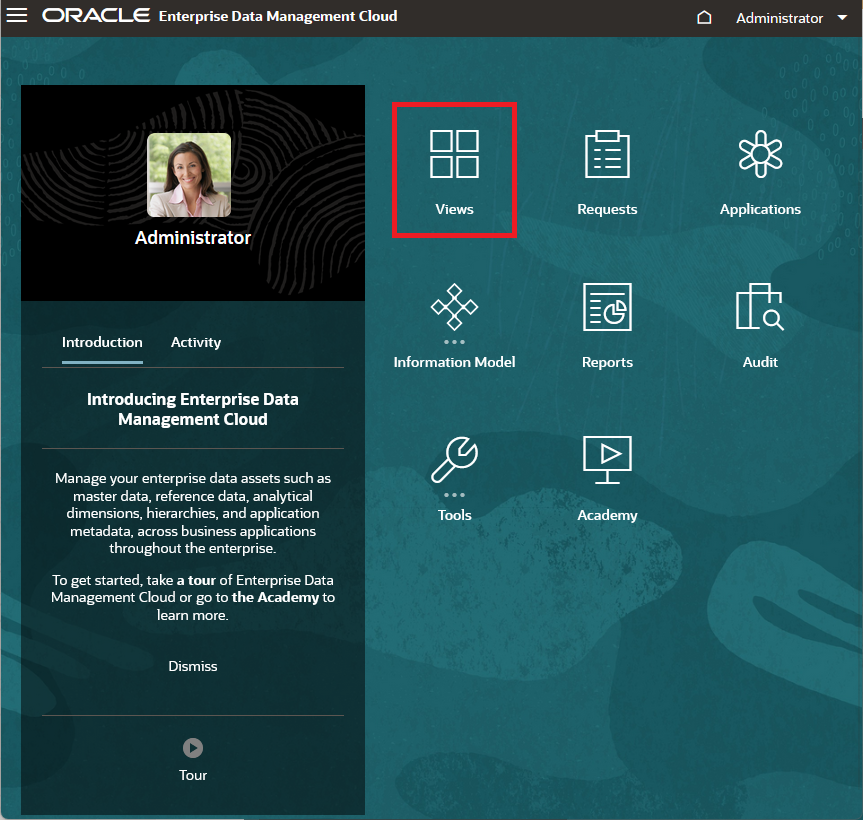
- In the Views page, click Corporate Planning to open the view.
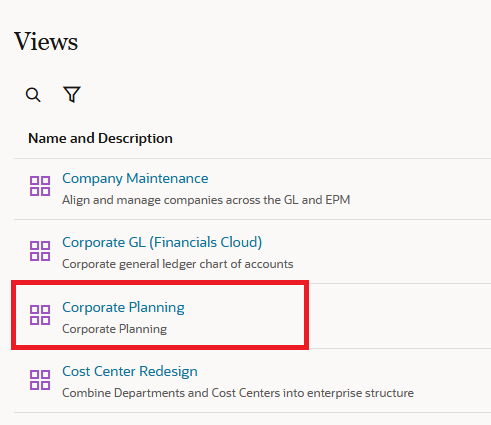
- In the Corporate Planning view, select the Product viewpoint.
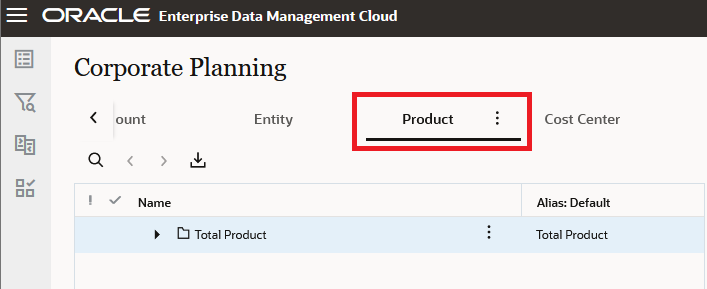
- In the Product hierarchy, expand Total Product, then All Product, and then SmartPhones.

- Click New Request to add a product.
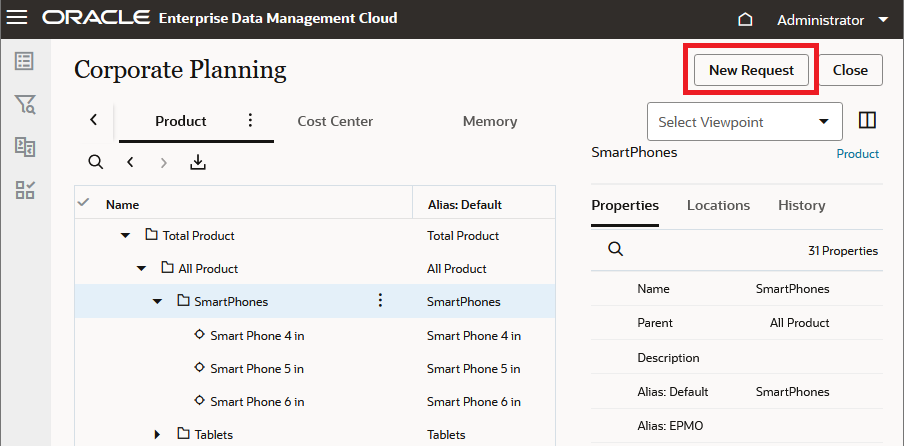
- In the SmartPhones row, click the Actions icon (
 ) and select Add Child.
) and select Add Child.

- Enter property values for the new product (for any properties not listed in the table, use the default value):
Property Value Name Smart Phone 7 in Description Smart Phone 7 in Plan Type (Plan1) False 
- Click Submit to commit the changes.

You receive a message that the request was successfully submitted.
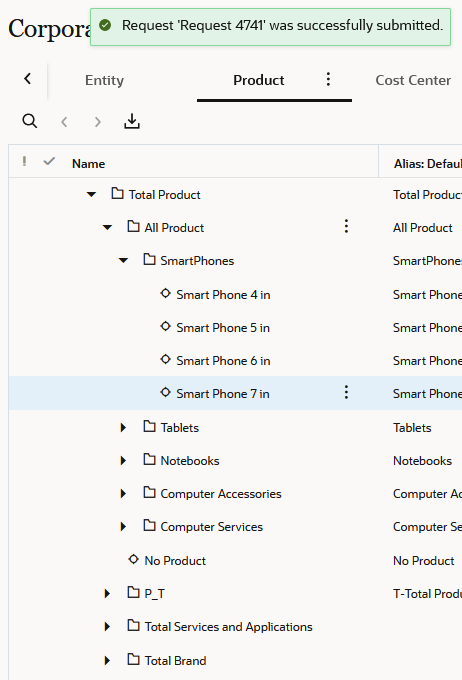
Submitting the request validates your changes. If there are no validation issues and there is no approval workflow defined, the changes are immediately commited to the dimension.
- Click Close to close the view, then return to the home page.
Exporting dimension metadata
In this section, you manually export the Product dimension metadata to the inbox of your Planning application, using the connection that you set up earlier.
- On the Enterprise Data Management Cloud home page, select Applications.
- In the Corporate Planning application row, click the Actions icon (
 ), and select Export.
), and select Export.

- Select the Product dimension.
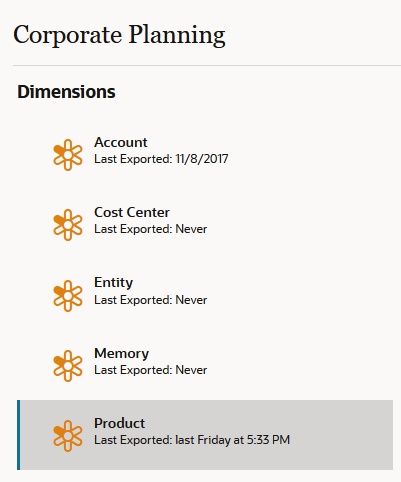
- Configure the export:
- Export Target: Connection
- Connection: Production
- Export file name: Product.csv

- Click Export.
You get a message that the export completed successfully.
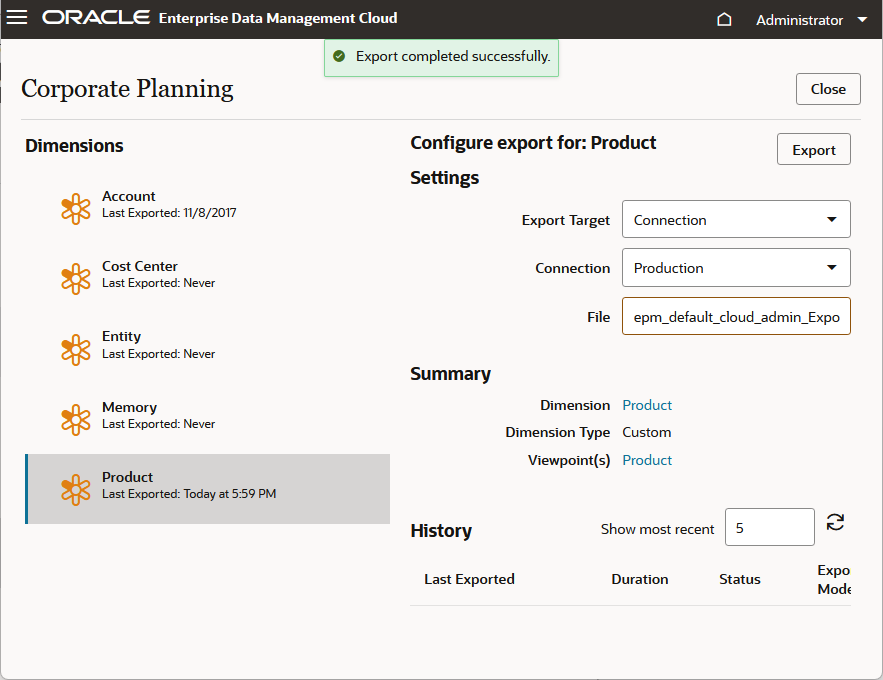
- Click Close.
Importing updated metadata to Planning
Viewing the exported file in Planning
In this section, you open the Planning Inbox/Outbox Explorer to verify that the Product.csv file was exported from Enterprise Data Management Cloud directly to your Planning instance.
- Open a new browser tab and log in to your Planning instance. From the home page, select Application, and then select Overview.
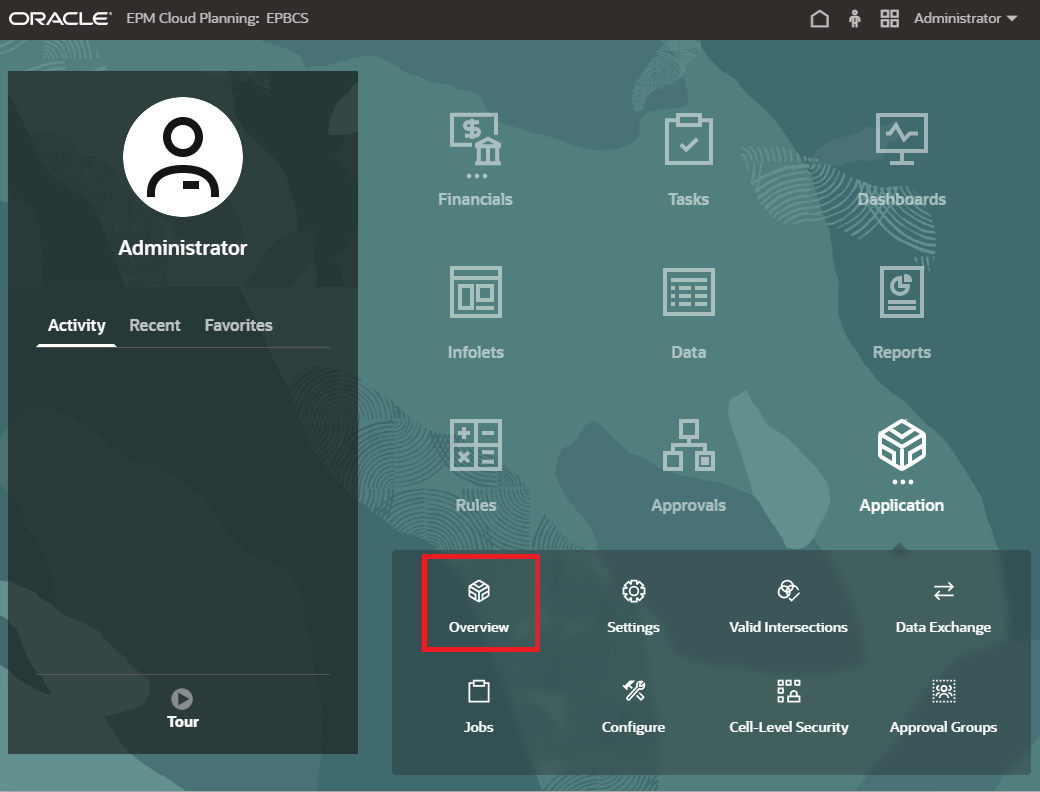
- In the Application Overview page, click Actions, then select Inbox/Outbox Explorer.
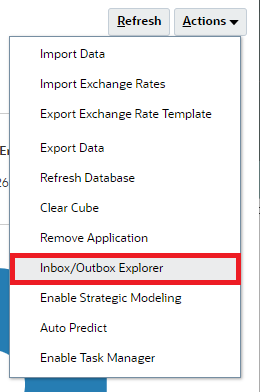
Notice that the Product.csv file has been exported from Enterprise Data Management Cloud to Planning.

- Click Close to return to the Application Overview page.
Creating an import job
To load files stored in the Planning Inbox/Outbox, you must create a saved import job. In this section, you create an import job for the Product.csv file.
- In the Application Overview page, select the Dimensions tab, and then click Import.

- In the Import Metadata dialog box, click Create.
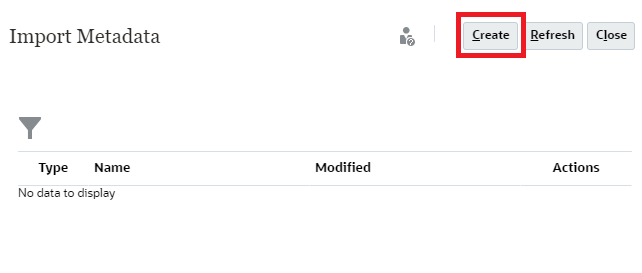
- For Location, select Inbox. In the Product dimension row, enter Product.csv, and accept the default (Comma delimited) for the File Type.
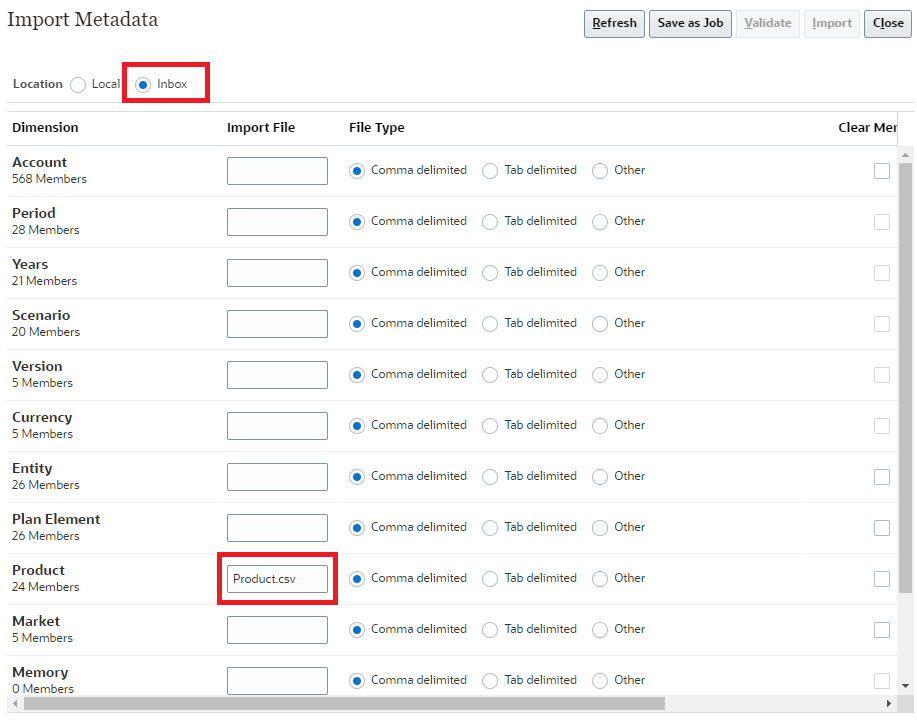
-
Click Save as Job.
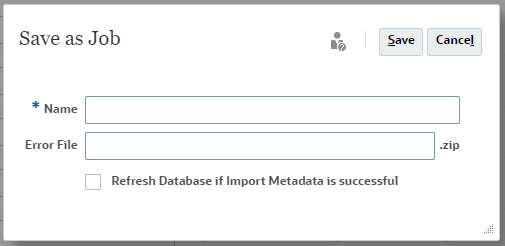
- Configure the job:
- Name: Import_Product
- Error File: edmc_product_error
Note:
This file provides information about the metadata records that were not imported for each dimension. If you specify an error zip file, a separate error file is created for each dimension, then the error files are zipped together, and the zip file is stored in the Outbox where you can download the file using Inbox/Outbox Explorer. - Refresh Database if Import Metadata is successful: Selected
Tip:
You must refresh the database after modifying dimensions and members. In a production environment, Oracle recommends that you notify all users, asking them to save their work and close the application, before you refresh the database. For more information on database refreshes, please see Before Refreshing the Database in Administering Planning.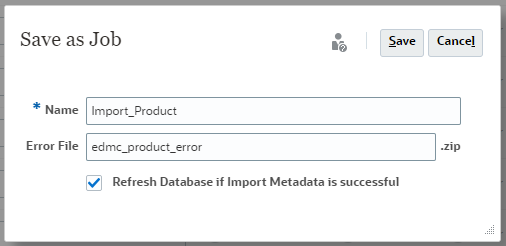
- Click Save, then click OK to close the information message.
- Click Close to close the Import Metadata dialog box that lists dimensions.
- In the Import Metadata dialog box that lists saved import metadata jobs, click Refresh to view the job you created.
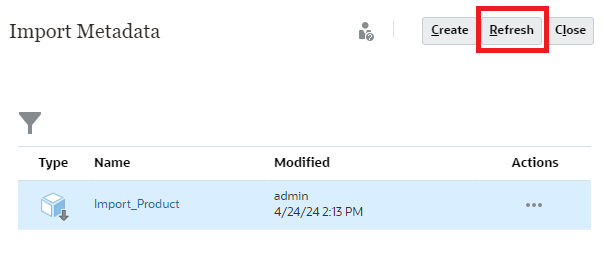
Running the import job and viewing results
In this section, you run the saved import job and verify that the new product is added to Planning.
- In the row for the import job, click the Actions icon and select Submit.
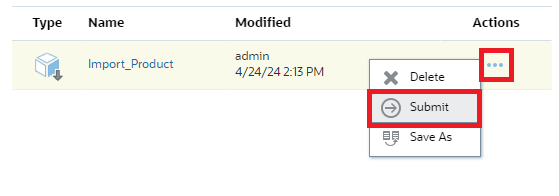
A confirmation message that the job was submitted successfully is displayed.

- Click OK to close the message, then click Close to close the Import Metadata dialog box.
- Select the Jobs tab to verify that the job completed successfully. Notice that the top two jobs listed in Recent Activity are the metadata import and the subsequent database refresh. The jobs completed successfully.
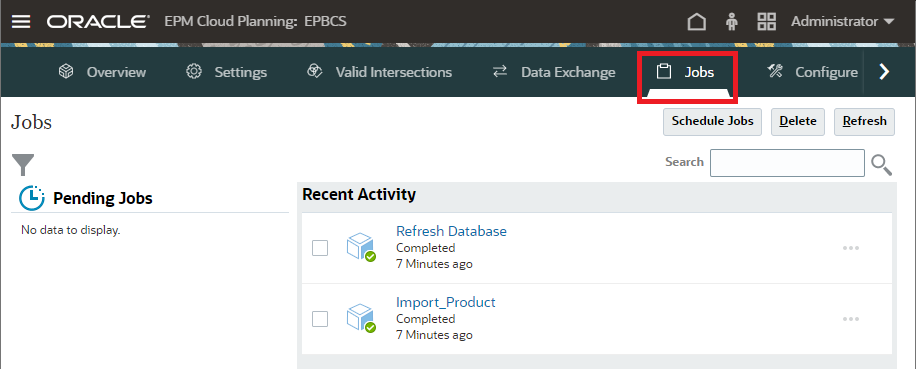
- Select the Overview tab to return to the application overview, then select the Dimensions tab again.
- In the Cube drop-down, select OEP_FS.

- Click Product to view the Product dimension.
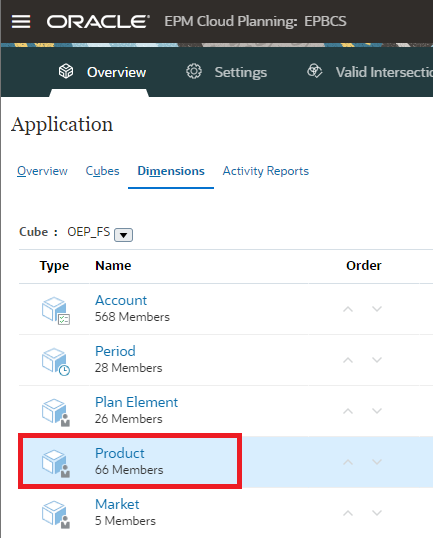
- Expand Total Product, then All Product, and then SmartPhones. Notice, that the new product, Smart Phone 7 in, was added to the dimension.

Next Steps
Related Links
Integrating dimension metadata from Enterprise Data Management Cloud with Planning using manual export and import
F41735-02
April, 2024